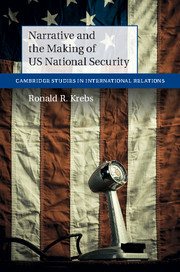Book contents
- Frontmatter
- Dedication
- Contents
- List of figures
- List of tables
- Acknowledgments
- 1 Narrating national security
- PART I Crisis, authority, and rhetorical mode: the fate of narrative projects, from the battle against isolationism to the War on Terror
- PART II Narrative at war: politics and rhetorical strategy in the military crucible, from Korea to Iraq
- Conclusion
- 9 Narrative in an age of fracture
- Appendices
- References
- Index
- Cambridge Studies in International Relations
9 - Narrative in an age of fracture
from Conclusion
Published online by Cambridge University Press: 05 December 2015
- Frontmatter
- Dedication
- Contents
- List of figures
- List of tables
- Acknowledgments
- 1 Narrating national security
- PART I Crisis, authority, and rhetorical mode: the fate of narrative projects, from the battle against isolationism to the War on Terror
- PART II Narrative at war: politics and rhetorical strategy in the military crucible, from Korea to Iraq
- Conclusion
- 9 Narrative in an age of fracture
- Appendices
- References
- Index
- Cambridge Studies in International Relations
Summary
Running for re-election in the summer of 2012, Barack Obama offered a public confession – albeit a safe one. His biggest mistake of the past four years, he told Charlie Rose, was not the substance of his policy, but the style of his leadership: “the nature of this office is also to tell a story to the American people that gives them a sense of unity and purpose and optimism, especially during tough times.” Self-proclaimed “serious” people prefer to debate the intricacies of policy and tend to dismiss style as superficial. But, Obama hinted, he had learned that, in the real world of presidential politics, style and substance are linked. The policy wonks who hold forth in Washington's seminar rooms gravitate toward the instrumental mode of argumentation, toward the assessment of costs and benefits. Sometimes, they embrace the normative mode, a rhetorical world of rights and wrongs. But they generally frame their arguments within an existing conversation. However, a president who refuses to play his part as narrator-in-chief, and who thus allows others to seize the rostrum and set the terms of debate, will find himself stymied. Obama's confession granted some credence to critics on the Left who charged that he had failed to use his bully pulpit – although, had the moderate Obama followed his own advice, he would not have set forth a narrative to their liking.
In that interview, Obama emphasized the importance of narrative leadership in domestic affairs, but both the demand for and limits of such storytelling apply equally to the realm of foreign affairs, specifically national security. Policy arguments in this arena too always rest on implicit, often truncated, narratives depicting the protagonists, the setting, and the action of a global drama. Such narratives define the national interest and identify the global challenges and opportunities facing the polity. In their absence, leaders could not set priorities or fashion a menu of appropriate responses. Such narratives, in other words, constitute the basis for grand strategy – the state's plan for how it can achieve its ends abroad, given limited resources. Were such narratives countless, or were they readily adopted and abandoned as events demand, a narrative perspective would add little to more traditional accounts of national security policy. This book takes issue with, and provides evidence against, both of these propositions.
- Type
- Chapter
- Information
- Narrative and the Making of US National Security , pp. 276 - 300Publisher: Cambridge University PressPrint publication year: 2015

